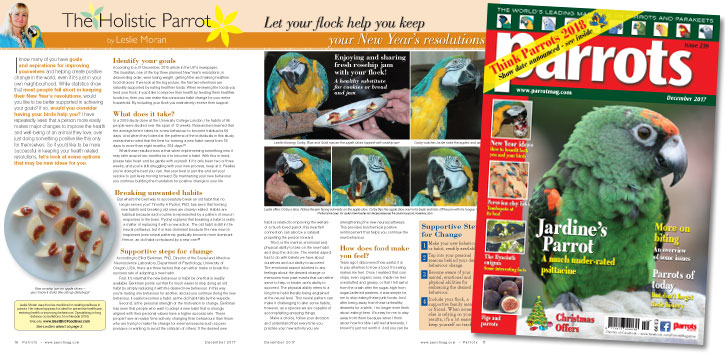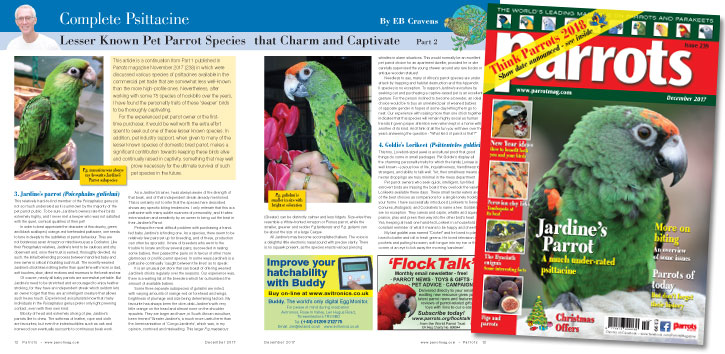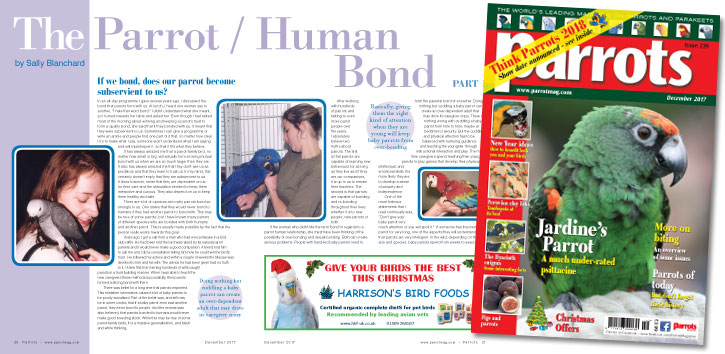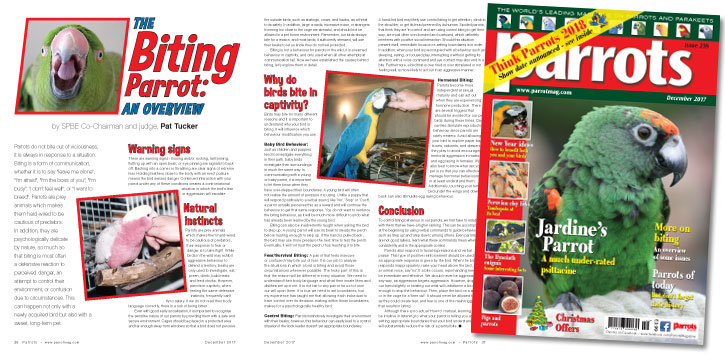
The Holistic Parrot by Leslie Moran
I know many of you have goals and aspirations for improving yourselves and helping create positive change in the world, even if it’s just in your own neighbourhood. While statistics show that most people fall short in keeping their New Year’s resolutions, would you like to be better supported in achieving your goals? If so, would you consider having your birds help you? I have repeatedly seen that a person more easily makes major changes to improve the health and well-being of an animal they love, over just doing something positive like this only for themselves. So if you’d like to be more successful in keeping your health related resolutions, let’s look at some options that may be new ideas for you.
According to a 31 December, 2015 article in the UK’s newspaper, The Guardian, one of the top three planned New Year’s resolutions, in descending order, were losing weight, getting fitter and making healthier food choices. If we look at the big picture, the first two intentions are naturally supported by eating healthier foods. When reviewing the foods you feed your flock, if you’d like to improve their health by feeding them healthier foods too, then you can make this conscious habit change for your entire household. By including your flock you instinctively receive their support.
Buy Now!

Complete Psittacine by Eb Cravens
This article is a continuation from Part 1 published in Parrots magazine November 2017 (238) in which were discussed various species of psittacines available in the commercial pet trade that are somewhat less well-known than the more high-profile ones. Nevertheless, after working with some 75 species of hookbills over the years, I have found the personality traits of these ‘sleeper’ birds to be thoroughly captivating.
For the experienced pet parrot owner or the first-time purchaser, it would be well worth the extra effort spent to seek out one of these lesser known species. In addition, pet industry support, when given to many of the lesser known species of domestic bred parrot, makes a significant contribution towards keeping these birds alive and continually raised in captivity, something that may well prove necessary for the ultimate survival of such pet species in the future.
This relatively hard-to-find member of the Poicephalus genus is not so much underrated as it is unknown by the majority of the pet parrot public. To be sure, Jardine’s owners rate their birds extremely highly, and I never met a keeper who was not satisfied with the quiet, comical qualities of their pet!
Buy Now!

In an all-day programme I gave several years ago, I discussed the bond that parrots form with us. At lunch, I heard one woman say to another, “I hate that word bond.” I didn't understand what she meant, so I turned towards her table and asked her. Even though I had talked most of the morning about winning and keeping a parrot's trust to form a quality bond, she said that if they bonded with us, it meant that they were subservient to us. Sometimes I can give a programme or write an article and people find one part of it that, no matter how clear I try to make what I say, someone won't understand what I am saying and will misinterpret it, so that it fits what they believe.
It has always amazed me that a parrot-family bird, no matter how small or big, will actually form a loving mutual bond with us when we are so much larger than they are. It also has always amazed me that they don't see us as predators and that they learn to trust us. In my mind, this certainly doesn't imply that they are subservient to us. It does however, mean that they are dependent on us for their care and the stimulation needed to keep them interactive and curious. They also depend on us to keep them healthy and safe.
Buy Now!

An Overview by SPBE Co-Chairman and judge, Pat Tucker
Parrots do not bite out of viciousness, it is always in response to a situation. Biting is a form of communication, whether it is to say "leave me alone", "I'm afraid", "I'm the boss of you", "I'm busy", 'I don't feel well", or "I want to breed". Parrots are prey animals which makes them hard-wired to be cautious of predators. In addition, they are psychologically delicate by nature, so much so that biting is most often a defensive reaction to perceived danger, an attempt to control their environment, or confusion due to circumstances. This can happen not only with a newly acquired bird but also with a sweet, long-term pet.
There are warning signs - hissing and/or rocking, tail fanning, fluffing up with an open beak, or eye pinning are signals to back off. Backing into a corner or thrashing are clear signs of extreme fear. Holding feathers close to the body with an erect posture means the bird senses danger. Continued interaction with your parrot under any of these conditions creates a confrontational situation in which the bird's fear or aggression will escalate..
Buy Now!




